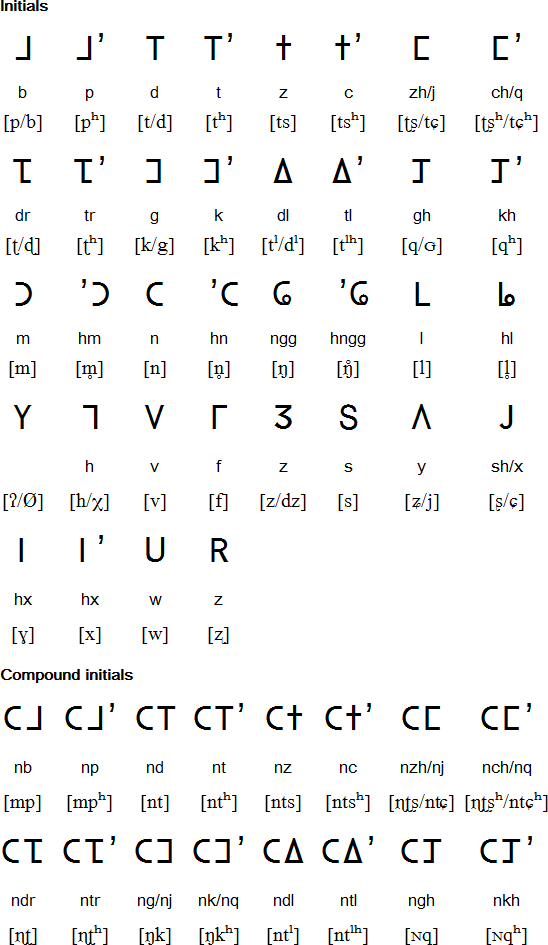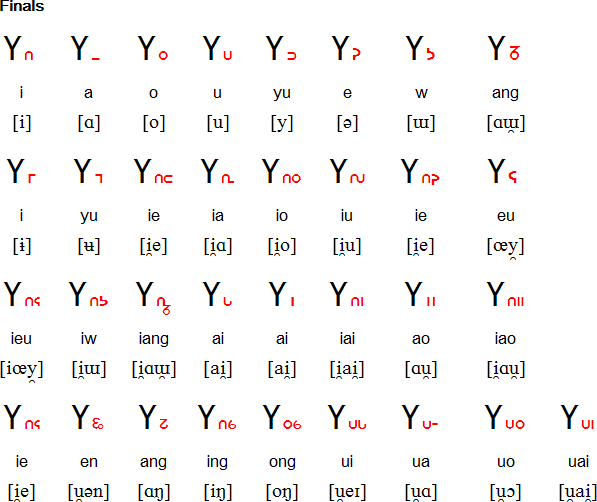The authorities in Beijing were not too keen on a writing system invented by a foreign missionary and in 1957 they introduced an alternative system based on Hànyŭ Pīnyīn. This was not popular among the A-Hmao people, who were already familiar with the Pollard system.
Various efforts have been made to improve Pollard Miao writing, which inadequately represents the phonetics and tones of A-Hmao and is not ideal for writing Chinese loan words. A semi-official 'reformed' Pollard script has been in use since 1988, along with the older version of the script, and the pīnyīn version.
Notable features
- Type of writing system: abugida with alphabetic elements
- Direction of writing: left to right in horizontal lines
- Vowels (finals) are written in small letters around the consonants (initials). The positioning of the vowels indicates the tone of a syllable. An alternative system of tone indication is used in the 1988 version of the script.
Used to write
A-Hmao, a Hmong-Mien language spoken by about 300,000 people in Guizhou and Yunnan provinces in southern China. This language is also known as Large Flowery Miao or 大花苗 (dàhuāmiáo) in Chinese.Lipo (Lolopo / Lolongo), a member of the Lolo branch of Tibeto-Burman languages spoken in China, Burma, India and Thailand by about 420,000 people.
Sichuan Miao, or Sichuan-Guizhou-Yunnan Miao, a Hmong-Mien language spoken in Sichuan, Guizhou and Yunnan in China.
Nasu or Eastern Yi, a member of the Lolo branch of Tibeto-Burman languages spoken in Guizhou, Yunnan and Sichuan in China by about 800,000 people.
Pollard script
This chart shows the Pollard script with the Pinyin equivalents of each letter and IPA transcriptions of the pronunciation.
Finals

Tone indication

Notes
- When the initials zh, ch, nzh, nch and sh are followed by the final i or any diphthong beginning with i the Pinyin equivalents become j, q, nj, nq and x respectively.
- In Pinyin tones are indicated by letters added to the ends of words. The numbers under the tones indicate the tone contours: 1 = low and 5 = high, so 11 is a low level tone, 55 is a high level tone, and 24 is a rising tone.
Links
Information about the Pollard script and A-Hmao languagehttp://en.wikipedia.org/wiki/Pollard_script
http://www.archives.ecs.soton.ac.uk/miao/WritingMiao/m001eqv.pdf
http://www.hmonglanguage.net/index.php/ntawv-pollard
http://en.wikipedia.org/wiki/A-Hmao_language
http://zh.wikipedia.org/wiki/苗语滇东北次方言
Songs and Stories and a Glossary of Phrases of the Hua Miao of South West China (includes free font): http://www.archives.ecs.soton.ac.uk/miao/
No comments:
Post a Comment
Note: Only a member of this blog may post a comment.